Taxation Law: Analyzing Income, Fringe Benefits, and Capital Gains Tax
VerifiedAdded on 2023/06/11
|6
|1330
|437
Homework Assignment
AI Summary
This Taxation Law assignment solution addresses several key areas of Australian tax law. It examines whether payments received by Hilary for her autobiography, manuscript, and photographs qualify as income from personal exertion, concluding they do not due to the payments being for the information itself rather than writing skill. The assignment then calculates the taxable value of a car fringe benefit using the statutory formula, considering the car's base value, statutory percentage, days of use, and employee deductions. Furthermore, it analyzes the tax implications of a son's repayment to his parent, determining that the principal repayment is a capital receipt and the incremental amount is a gift, thus not subject to tax. Finally, the assignment addresses capital gains tax (CGT) implications on the sale of a property purchased before CGT existed, calculating taxable gains on the house portion and considering scenarios involving sale to a related party and ownership by a company. Desklib provides a platform for students to access similar solved assignments and study resources.
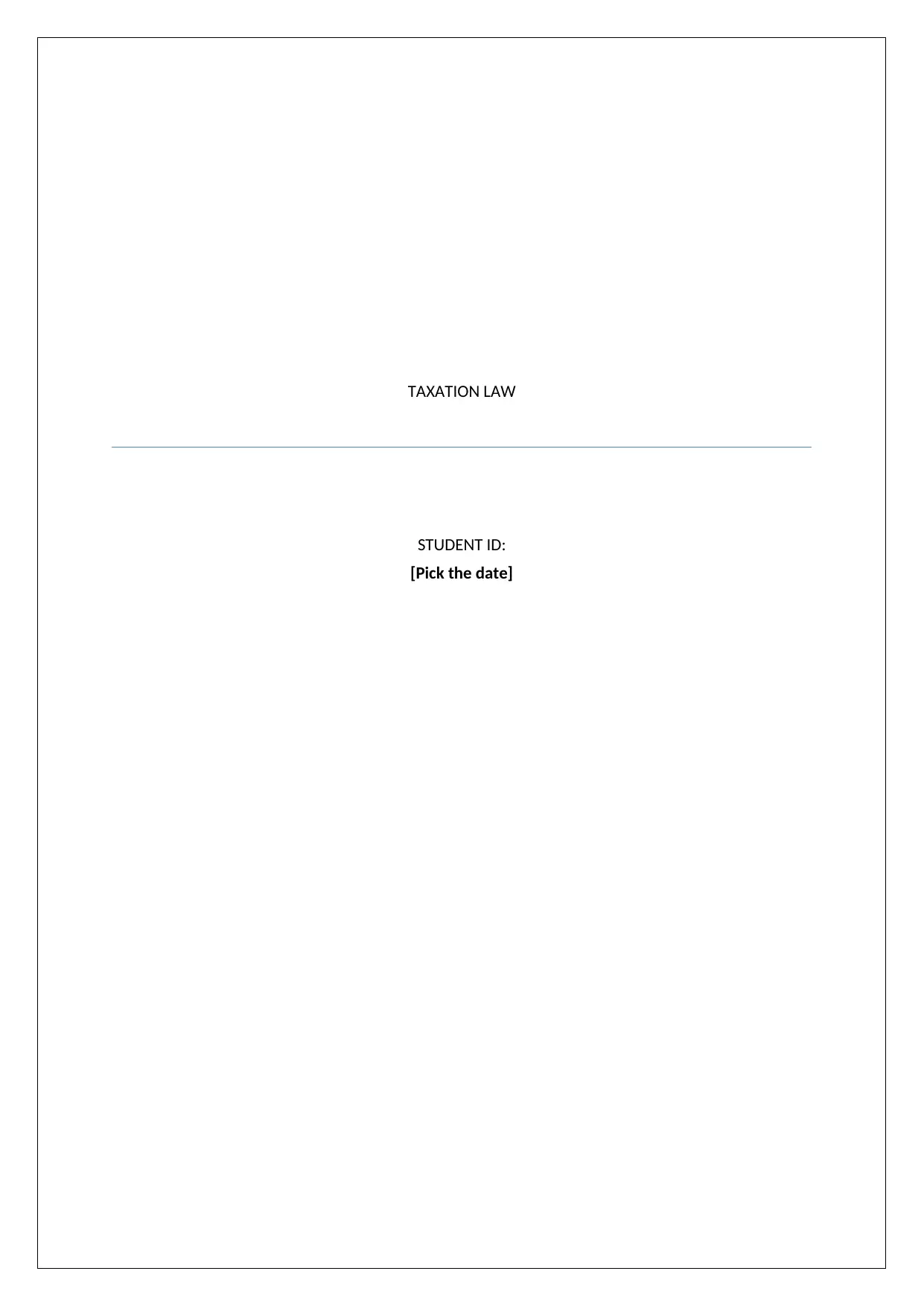
TAXATION LAW
STUDENT ID:
[Pick the date]
STUDENT ID:
[Pick the date]
Paraphrase This Document
Need a fresh take? Get an instant paraphrase of this document with our AI Paraphraser
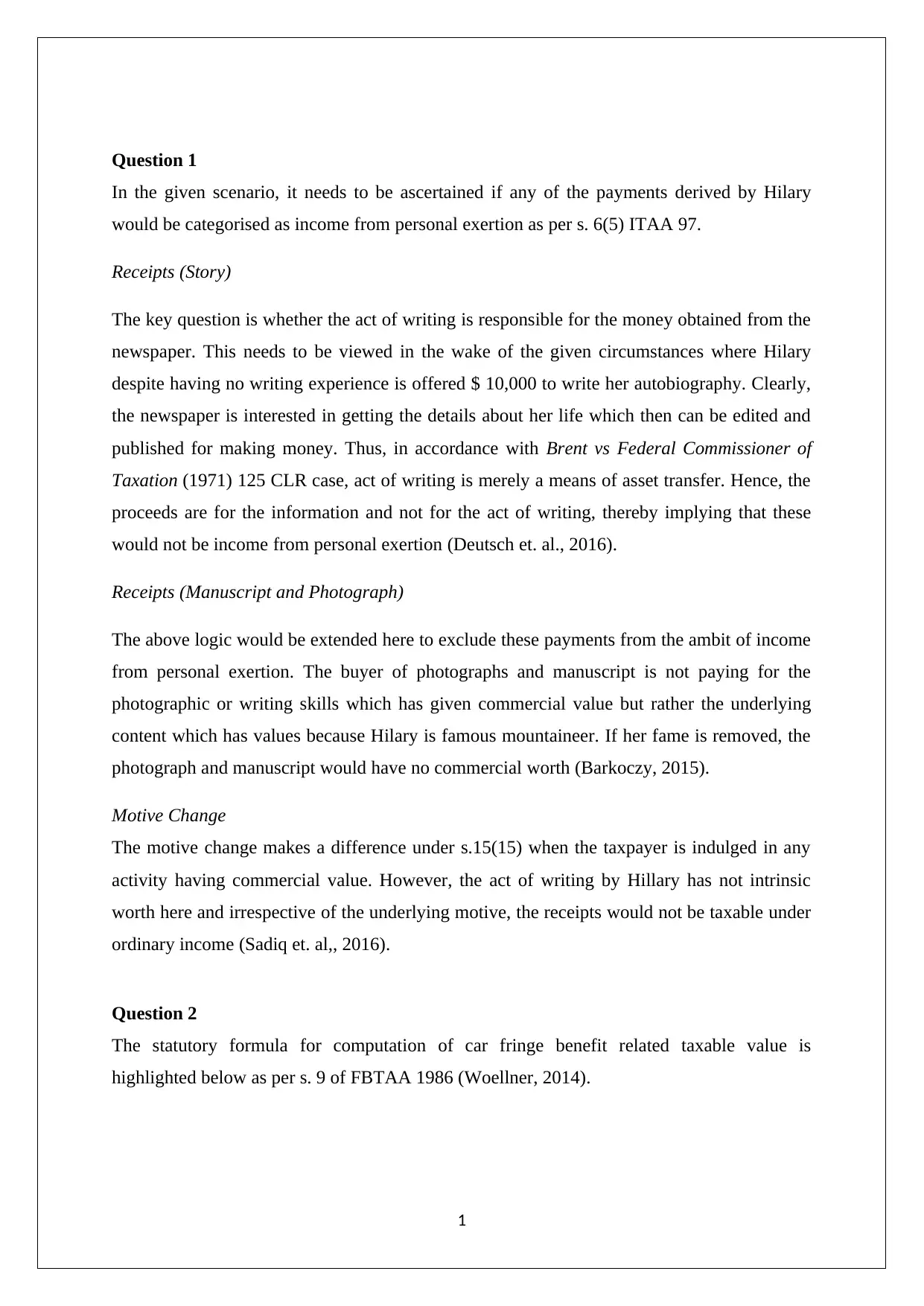
Question 1
In the given scenario, it needs to be ascertained if any of the payments derived by Hilary
would be categorised as income from personal exertion as per s. 6(5) ITAA 97.
Receipts (Story)
The key question is whether the act of writing is responsible for the money obtained from the
newspaper. This needs to be viewed in the wake of the given circumstances where Hilary
despite having no writing experience is offered $ 10,000 to write her autobiography. Clearly,
the newspaper is interested in getting the details about her life which then can be edited and
published for making money. Thus, in accordance with Brent vs Federal Commissioner of
Taxation (1971) 125 CLR case, act of writing is merely a means of asset transfer. Hence, the
proceeds are for the information and not for the act of writing, thereby implying that these
would not be income from personal exertion (Deutsch et. al., 2016).
Receipts (Manuscript and Photograph)
The above logic would be extended here to exclude these payments from the ambit of income
from personal exertion. The buyer of photographs and manuscript is not paying for the
photographic or writing skills which has given commercial value but rather the underlying
content which has values because Hilary is famous mountaineer. If her fame is removed, the
photograph and manuscript would have no commercial worth (Barkoczy, 2015).
Motive Change
The motive change makes a difference under s.15(15) when the taxpayer is indulged in any
activity having commercial value. However, the act of writing by Hillary has not intrinsic
worth here and irrespective of the underlying motive, the receipts would not be taxable under
ordinary income (Sadiq et. al,, 2016).
Question 2
The statutory formula for computation of car fringe benefit related taxable value is
highlighted below as per s. 9 of FBTAA 1986 (Woellner, 2014).
1
In the given scenario, it needs to be ascertained if any of the payments derived by Hilary
would be categorised as income from personal exertion as per s. 6(5) ITAA 97.
Receipts (Story)
The key question is whether the act of writing is responsible for the money obtained from the
newspaper. This needs to be viewed in the wake of the given circumstances where Hilary
despite having no writing experience is offered $ 10,000 to write her autobiography. Clearly,
the newspaper is interested in getting the details about her life which then can be edited and
published for making money. Thus, in accordance with Brent vs Federal Commissioner of
Taxation (1971) 125 CLR case, act of writing is merely a means of asset transfer. Hence, the
proceeds are for the information and not for the act of writing, thereby implying that these
would not be income from personal exertion (Deutsch et. al., 2016).
Receipts (Manuscript and Photograph)
The above logic would be extended here to exclude these payments from the ambit of income
from personal exertion. The buyer of photographs and manuscript is not paying for the
photographic or writing skills which has given commercial value but rather the underlying
content which has values because Hilary is famous mountaineer. If her fame is removed, the
photograph and manuscript would have no commercial worth (Barkoczy, 2015).
Motive Change
The motive change makes a difference under s.15(15) when the taxpayer is indulged in any
activity having commercial value. However, the act of writing by Hillary has not intrinsic
worth here and irrespective of the underlying motive, the receipts would not be taxable under
ordinary income (Sadiq et. al,, 2016).
Question 2
The statutory formula for computation of car fringe benefit related taxable value is
highlighted below as per s. 9 of FBTAA 1986 (Woellner, 2014).
1
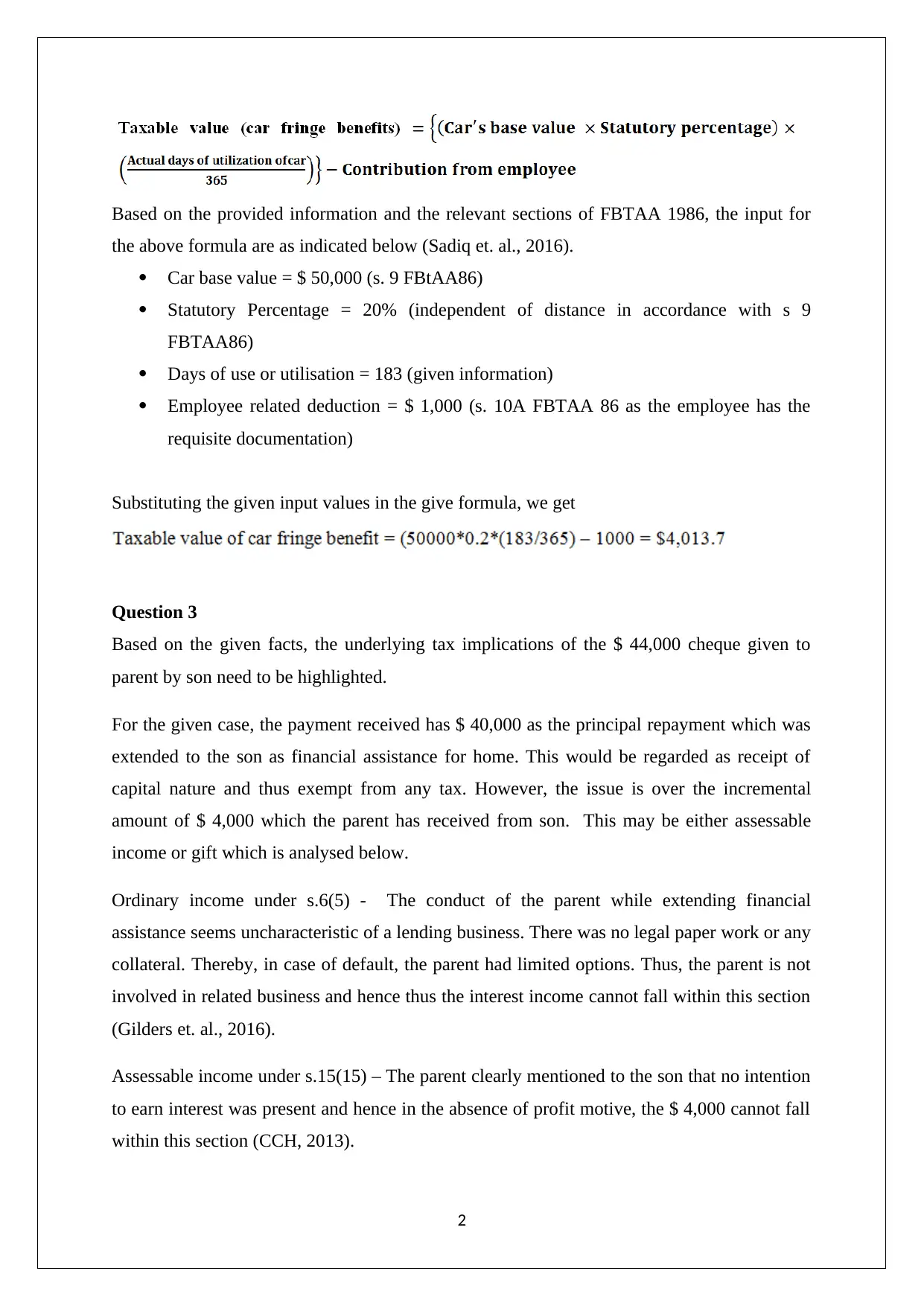
Based on the provided information and the relevant sections of FBTAA 1986, the input for
the above formula are as indicated below (Sadiq et. al., 2016).
Car base value = $ 50,000 (s. 9 FBtAA86)
Statutory Percentage = 20% (independent of distance in accordance with s 9
FBTAA86)
Days of use or utilisation = 183 (given information)
Employee related deduction = $ 1,000 (s. 10A FBTAA 86 as the employee has the
requisite documentation)
Substituting the given input values in the give formula, we get
Question 3
Based on the given facts, the underlying tax implications of the $ 44,000 cheque given to
parent by son need to be highlighted.
For the given case, the payment received has $ 40,000 as the principal repayment which was
extended to the son as financial assistance for home. This would be regarded as receipt of
capital nature and thus exempt from any tax. However, the issue is over the incremental
amount of $ 4,000 which the parent has received from son. This may be either assessable
income or gift which is analysed below.
Ordinary income under s.6(5) - The conduct of the parent while extending financial
assistance seems uncharacteristic of a lending business. There was no legal paper work or any
collateral. Thereby, in case of default, the parent had limited options. Thus, the parent is not
involved in related business and hence thus the interest income cannot fall within this section
(Gilders et. al., 2016).
Assessable income under s.15(15) – The parent clearly mentioned to the son that no intention
to earn interest was present and hence in the absence of profit motive, the $ 4,000 cannot fall
within this section (CCH, 2013).
2
the above formula are as indicated below (Sadiq et. al., 2016).
Car base value = $ 50,000 (s. 9 FBtAA86)
Statutory Percentage = 20% (independent of distance in accordance with s 9
FBTAA86)
Days of use or utilisation = 183 (given information)
Employee related deduction = $ 1,000 (s. 10A FBTAA 86 as the employee has the
requisite documentation)
Substituting the given input values in the give formula, we get
Question 3
Based on the given facts, the underlying tax implications of the $ 44,000 cheque given to
parent by son need to be highlighted.
For the given case, the payment received has $ 40,000 as the principal repayment which was
extended to the son as financial assistance for home. This would be regarded as receipt of
capital nature and thus exempt from any tax. However, the issue is over the incremental
amount of $ 4,000 which the parent has received from son. This may be either assessable
income or gift which is analysed below.
Ordinary income under s.6(5) - The conduct of the parent while extending financial
assistance seems uncharacteristic of a lending business. There was no legal paper work or any
collateral. Thereby, in case of default, the parent had limited options. Thus, the parent is not
involved in related business and hence thus the interest income cannot fall within this section
(Gilders et. al., 2016).
Assessable income under s.15(15) – The parent clearly mentioned to the son that no intention
to earn interest was present and hence in the absence of profit motive, the $ 4,000 cannot fall
within this section (CCH, 2013).
2
⊘ This is a preview!⊘
Do you want full access?
Subscribe today to unlock all pages.

Trusted by 1+ million students worldwide
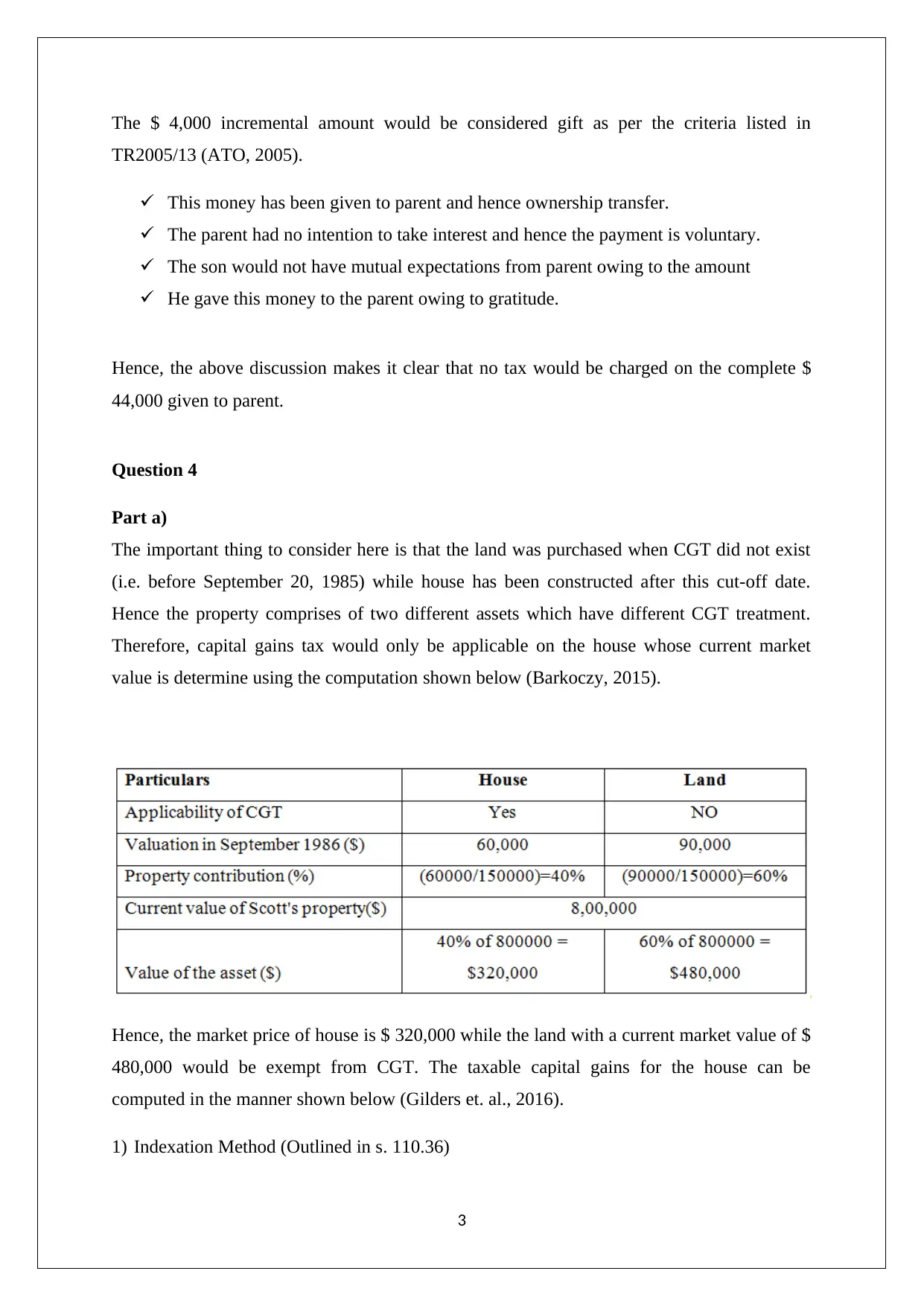
The $ 4,000 incremental amount would be considered gift as per the criteria listed in
TR2005/13 (ATO, 2005).
This money has been given to parent and hence ownership transfer.
The parent had no intention to take interest and hence the payment is voluntary.
The son would not have mutual expectations from parent owing to the amount
He gave this money to the parent owing to gratitude.
Hence, the above discussion makes it clear that no tax would be charged on the complete $
44,000 given to parent.
Question 4
Part a)
The important thing to consider here is that the land was purchased when CGT did not exist
(i.e. before September 20, 1985) while house has been constructed after this cut-off date.
Hence the property comprises of two different assets which have different CGT treatment.
Therefore, capital gains tax would only be applicable on the house whose current market
value is determine using the computation shown below (Barkoczy, 2015).
Hence, the market price of house is $ 320,000 while the land with a current market value of $
480,000 would be exempt from CGT. The taxable capital gains for the house can be
computed in the manner shown below (Gilders et. al., 2016).
1) Indexation Method (Outlined in s. 110.36)
3
TR2005/13 (ATO, 2005).
This money has been given to parent and hence ownership transfer.
The parent had no intention to take interest and hence the payment is voluntary.
The son would not have mutual expectations from parent owing to the amount
He gave this money to the parent owing to gratitude.
Hence, the above discussion makes it clear that no tax would be charged on the complete $
44,000 given to parent.
Question 4
Part a)
The important thing to consider here is that the land was purchased when CGT did not exist
(i.e. before September 20, 1985) while house has been constructed after this cut-off date.
Hence the property comprises of two different assets which have different CGT treatment.
Therefore, capital gains tax would only be applicable on the house whose current market
value is determine using the computation shown below (Barkoczy, 2015).
Hence, the market price of house is $ 320,000 while the land with a current market value of $
480,000 would be exempt from CGT. The taxable capital gains for the house can be
computed in the manner shown below (Gilders et. al., 2016).
1) Indexation Method (Outlined in s. 110.36)
3
Paraphrase This Document
Need a fresh take? Get an instant paraphrase of this document with our AI Paraphraser
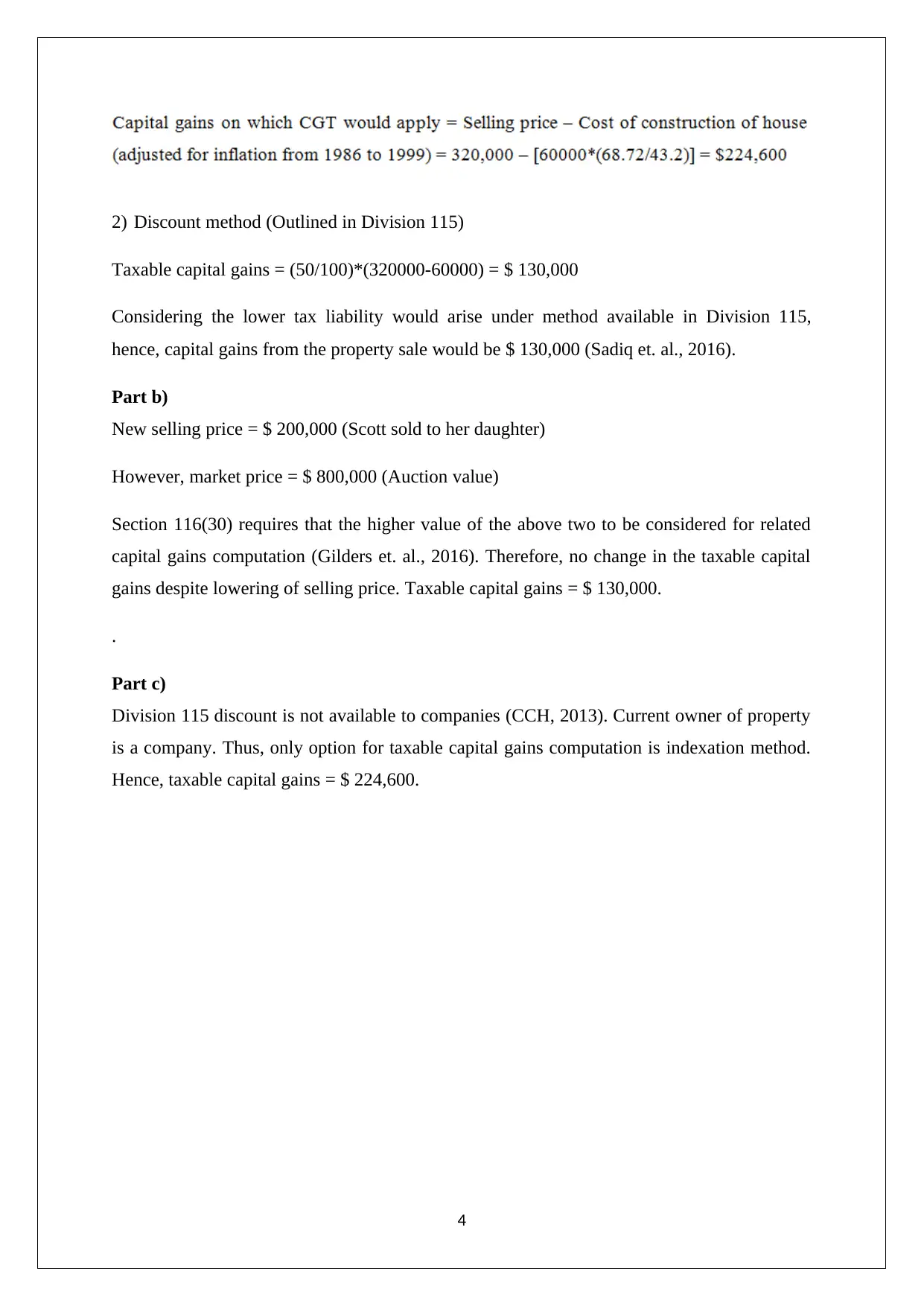
2) Discount method (Outlined in Division 115)
Taxable capital gains = (50/100)*(320000-60000) = $ 130,000
Considering the lower tax liability would arise under method available in Division 115,
hence, capital gains from the property sale would be $ 130,000 (Sadiq et. al., 2016).
Part b)
New selling price = $ 200,000 (Scott sold to her daughter)
However, market price = $ 800,000 (Auction value)
Section 116(30) requires that the higher value of the above two to be considered for related
capital gains computation (Gilders et. al., 2016). Therefore, no change in the taxable capital
gains despite lowering of selling price. Taxable capital gains = $ 130,000.
.
Part c)
Division 115 discount is not available to companies (CCH, 2013). Current owner of property
is a company. Thus, only option for taxable capital gains computation is indexation method.
Hence, taxable capital gains = $ 224,600.
4
Taxable capital gains = (50/100)*(320000-60000) = $ 130,000
Considering the lower tax liability would arise under method available in Division 115,
hence, capital gains from the property sale would be $ 130,000 (Sadiq et. al., 2016).
Part b)
New selling price = $ 200,000 (Scott sold to her daughter)
However, market price = $ 800,000 (Auction value)
Section 116(30) requires that the higher value of the above two to be considered for related
capital gains computation (Gilders et. al., 2016). Therefore, no change in the taxable capital
gains despite lowering of selling price. Taxable capital gains = $ 130,000.
.
Part c)
Division 115 discount is not available to companies (CCH, 2013). Current owner of property
is a company. Thus, only option for taxable capital gains computation is indexation method.
Hence, taxable capital gains = $ 224,600.
4
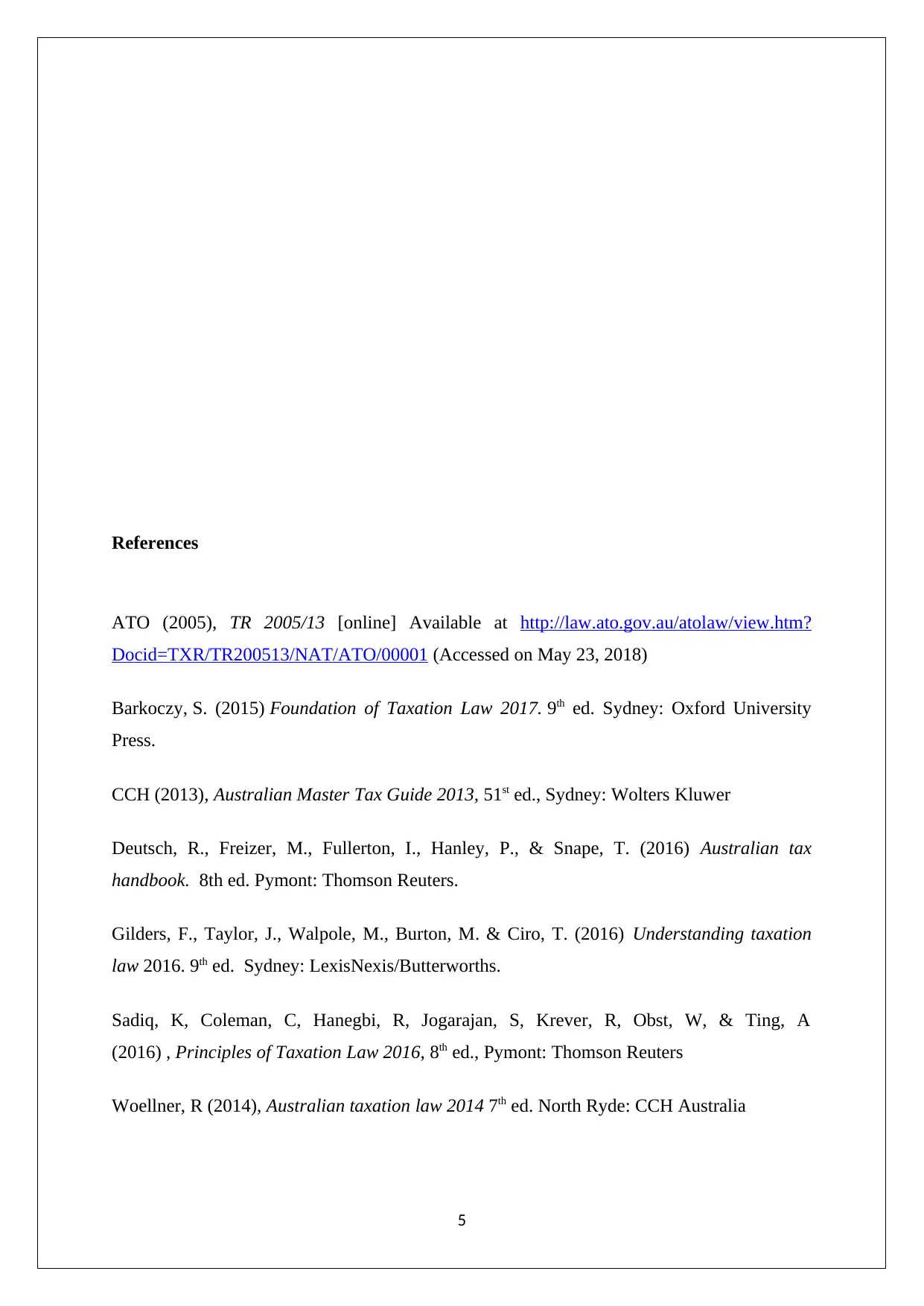
References
ATO (2005), TR 2005/13 [online] Available at http://law.ato.gov.au/atolaw/view.htm?
Docid=TXR/TR200513/NAT/ATO/00001 (Accessed on May 23, 2018)
Barkoczy, S. (2015) Foundation of Taxation Law 2017. 9th ed. Sydney: Oxford University
Press.
CCH (2013), Australian Master Tax Guide 2013, 51st ed., Sydney: Wolters Kluwer
Deutsch, R., Freizer, M., Fullerton, I., Hanley, P., & Snape, T. (2016) Australian tax
handbook. 8th ed. Pymont: Thomson Reuters.
Gilders, F., Taylor, J., Walpole, M., Burton, M. & Ciro, T. (2016) Understanding taxation
law 2016. 9th ed. Sydney: LexisNexis/Butterworths.
Sadiq, K, Coleman, C, Hanegbi, R, Jogarajan, S, Krever, R, Obst, W, & Ting, A
(2016) , Principles of Taxation Law 2016, 8th ed., Pymont: Thomson Reuters
Woellner, R (2014), Australian taxation law 2014 7th ed. North Ryde: CCH Australia
5
ATO (2005), TR 2005/13 [online] Available at http://law.ato.gov.au/atolaw/view.htm?
Docid=TXR/TR200513/NAT/ATO/00001 (Accessed on May 23, 2018)
Barkoczy, S. (2015) Foundation of Taxation Law 2017. 9th ed. Sydney: Oxford University
Press.
CCH (2013), Australian Master Tax Guide 2013, 51st ed., Sydney: Wolters Kluwer
Deutsch, R., Freizer, M., Fullerton, I., Hanley, P., & Snape, T. (2016) Australian tax
handbook. 8th ed. Pymont: Thomson Reuters.
Gilders, F., Taylor, J., Walpole, M., Burton, M. & Ciro, T. (2016) Understanding taxation
law 2016. 9th ed. Sydney: LexisNexis/Butterworths.
Sadiq, K, Coleman, C, Hanegbi, R, Jogarajan, S, Krever, R, Obst, W, & Ting, A
(2016) , Principles of Taxation Law 2016, 8th ed., Pymont: Thomson Reuters
Woellner, R (2014), Australian taxation law 2014 7th ed. North Ryde: CCH Australia
5
⊘ This is a preview!⊘
Do you want full access?
Subscribe today to unlock all pages.

Trusted by 1+ million students worldwide
1 out of 6
Related Documents
Your All-in-One AI-Powered Toolkit for Academic Success.
+13062052269
info@desklib.com
Available 24*7 on WhatsApp / Email
![[object Object]](/_next/static/media/star-bottom.7253800d.svg)
Unlock your academic potential
Copyright © 2020–2025 A2Z Services. All Rights Reserved. Developed and managed by ZUCOL.





